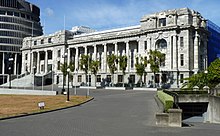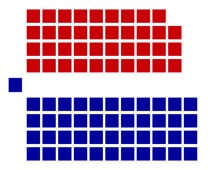36th Parliament of New Zealand
| Thirty-sixth Parliament of New Zealand | |||||
|---|---|---|---|---|---|
|
|||||

|
|||||
| Overview | |||||
| Term | 12 March 1970 – 20 October 1972 | ||||
| Election | New Zealand general election, 1969 | ||||
| Government | Second National Government | ||||
| House of Representatives | |||||
 |
|||||
| Members | 84 | ||||
| Speaker of the House |
Alfred E. Allen ––Roy Jack until 7 June 1972 |
||||
| Prime Minister |
Jack Marshall ––Keith Holyoake until 7 February 1972 |
||||
| Leader of the Opposition | Norman Kirk | ||||
| Sovereign | |||||
| Monarch | HM Elizabeth II | ||||
| Governor-General | HE Sir Denis Blundell from 27 September 1972 ––Sir Arthur Porritt until 7 September 1972 |
||||
The 36th New Zealand Parliament was a term of the New Zealand Parliament. It was elected at the 1969 general election on 29 November of that year.
The 1969 general election was held on Saturday, 29 November. A total of 84 MPs were elected; 55 represented North Island electorates, 25 represented South Island electorates, and the remaining four represented Māori electorates; this was an increase in the number of MPs by four since the 1966 election. 1,519,889 voters were enrolled and the official turnout at the election was 88.9%.
The 36th Parliament sat for three sessions, and was prorogued on 20 October 1972.
The National Party had come to power at the 1960 election, and Keith Holyoake had formed the second Holyoake Ministry on 12 December 1960, which stayed in power until Holyoake stepped down in early 1972. He was succeeded by Jack Marshall, who formed the Marshall Ministry on 7 February of that year. The second National Government was defeated at the 25 November 1972 election.
The table below shows the number of MPs in each party following the 1969 election and at dissolution:
Notes
The table below shows the results of the 1969 general election:
Key
National Labour Social Credit Independent
...
Wikipedia
